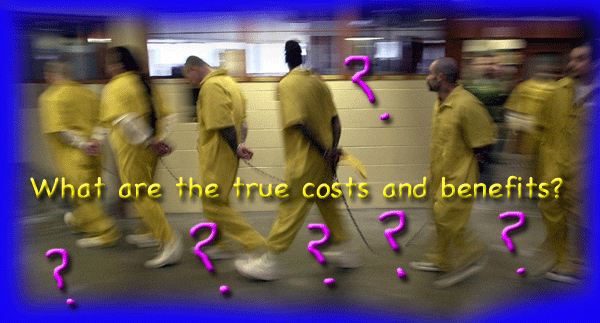REASON MAGAZINE TAKES ON THE CRIMINAL JUSTICE SYSTEM
Maybe this is a Nixon Goes to China moment, but, right now, some of the more persuasive voices attempting to rethink the US’s incarceration-policy-on-steroids are coming from the conservative side of the discussion.
An excellent case in point is the specially-themed July issue of Libertarian-leaning Reason Magazine, with its cover bannered: Criminal Injustice: Inside America’s National Disgrace.
Editor-in-chief Matt Welsh’s sets the tone for the rest of the issue with unsparing ferocity in his opening essay.
Here’s how it begins:
At the first presidential debate of the 2012 campaign, former New Mexico Gov. Gary Johnson implored Republican voters to conduct a “cost-benefit analysis” of the criminal justice system. “Half of what we spend on law enforcement, the courts, and the prisons is drug related, and to what end?” Johnson asked a South Carolina audience in May. “We’re arresting 1.8 million a year in this country; we now have 2.3 million people behind bars in this country. We have the highest incarceration rate of any country in the world. I would ask people to look at this issue; see if they don’t come to the same conclusion that I did, and that is that 90 percent of the drug problem is prohibition-related.”
The ends of justice, Johnson argues, have not justified the means of prosecution. This issue of reason is a detailed brief in support of that thesis. A system designed to protect the innocent has instead become a menagerie to imprison them. A legal code designed to proscribe specific behavior has instead become a vast, vague, and unpredictable invitation to selective enforcement. Public servants who swear on the Constitution to uphold the highest principles of justice go out of their way to stop prisoners from using DNA evidence to show they were wrongly convicted. Even before you start debating the means of the four-decade crackdown on crime and drugs, it’s important to acknowledge that the ends are riddled with serious problems.
America has one-quarter of the world’s prisoners. More than 7 million people are under correctional supervision in this country. These staggering statistics—no other country comes close in percentage terms, let alone raw numbers—have serious consequences. For one thing, there is the fiscal cost: The corrections system lags only Medicaid in government spending growth on the state level. Yet most prisons are overcrowded, underserviced, and exponentially more dangerous than any decent society should tolerate.
Worse are the cascading social effects, some of which you might not initially expect…..
DOING THE COST BENEFIT MATH
Elsewhere in the issue, Veronique de Rugy lays out an array of numbers that look at the cost benefit ratio of our incarceration addiction from a variety of perspectives.
Here’s a clip:
America’s enormously high incarceration rate is a relatively recent phenomenon. According to a 2010 report from the Center for Economic and Policy Research (CEPR), U.S. incarceration rates between 1880 and 1970 ranged from about 100 to 200 prisoners per 100,000 people. After 1980, however, the inmate population began to grow much more rapidly than the overall population, climbing from about 220 per 100,000 in 1980 to 458 in 1990, 683 in 2000, and 753 in 2008.
Why are American incarceration rates so high by international standards, and why have they increased so much during the last three decades? The simplest explanation would be that the rise in the incarceration rate reflects a commensurate rise in crime. But according to data from the Federal Bureau of Investigation and the Bureau of Justice Statistics (BJS), the total number of violent crimes was only about 3 percent higher in 2008 than it was in 1980, while the violent crime rate was much lower: 19 per 1,000 people in 2008 vs. 49.4 in 1980. Meanwhile, the BJS data shows that the total number of property crimes dropped to 134.7 per 1,000 people in 2008 from 496.1 in 1980. The growth in the prison population mainly reflects changes in the correctional policies that determine who goes to prison and for how long.
Mandatory minimum sentencing laws enacted in the 1980s played an important role. According to the CEPR study, nonviolent offenders make up more than 60 percent of the prison and jail population. Nonviolent drug offenders now account for about one-fourth of all inmates, up from less than 10 percent in 1980….
ADDING UP THE COLLATERAL COSTS
Another article features Harvard professor of sociology Bruce Western looking at the social damaged wreaked by incarceration—from the effect of a felony record on future employment for vast numbers of ex-inmates to the affect of imprisonment on an inmates family.
Here is how his story opens
Do prisons make us safer? By taking would-be offenders off the streets, prisons clearly have reduced crime in the short run. In the long run, though, imprisonment erodes the bonds of work, family, and community that help preserve public safety.
Three effects are fundamental. First, former prisoners do worse economically than if they had never been incarcerated…..
The last story in the package was one that I excerpted last week, about WRONGFUL CONVICTIONS.
Altogether, it is a strong, well-researched package that should be mandatory reading for every state legislator and member of congress.
(Read it yourself, and then you can tell them so.)
Photo from this award-winning series.

